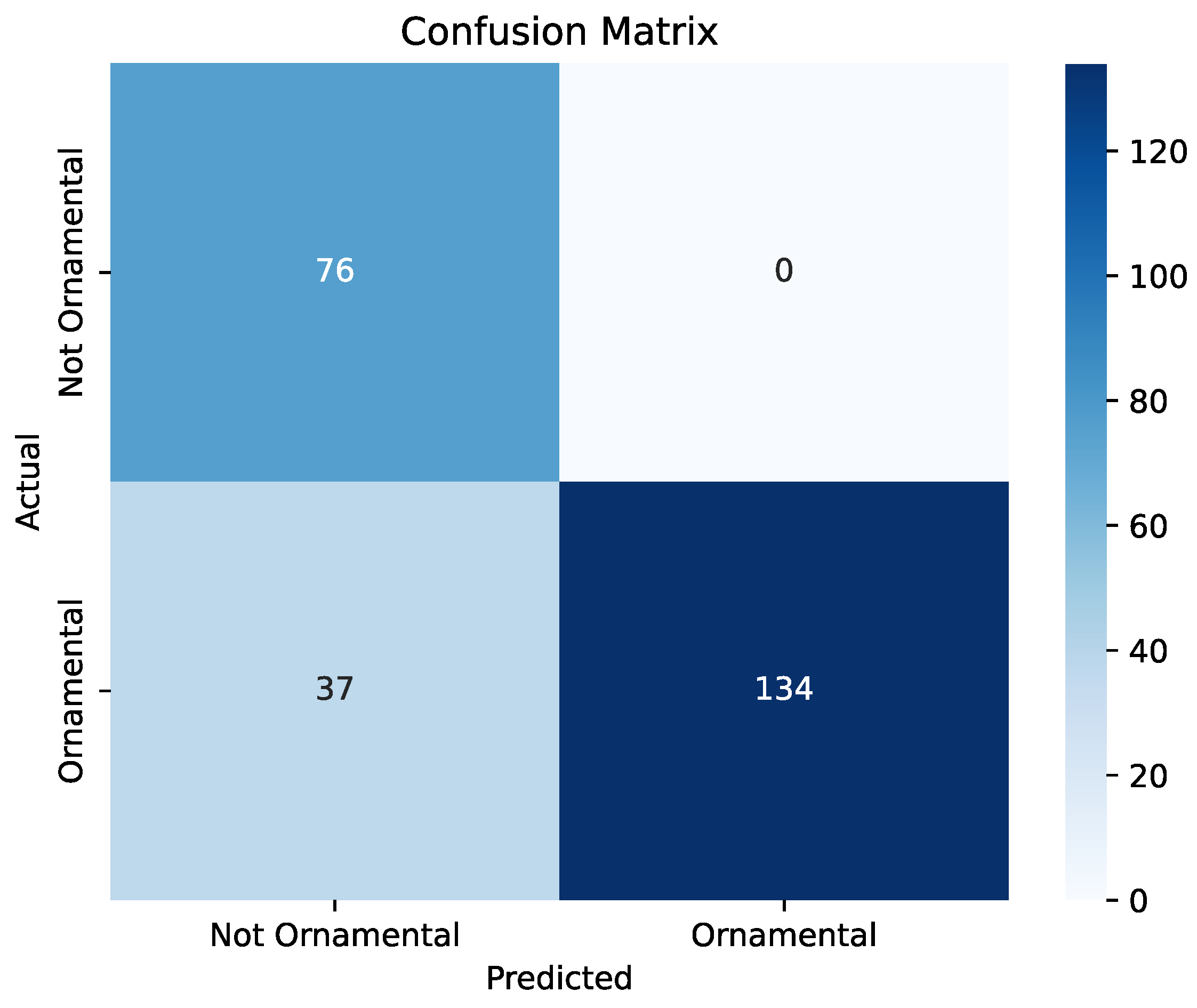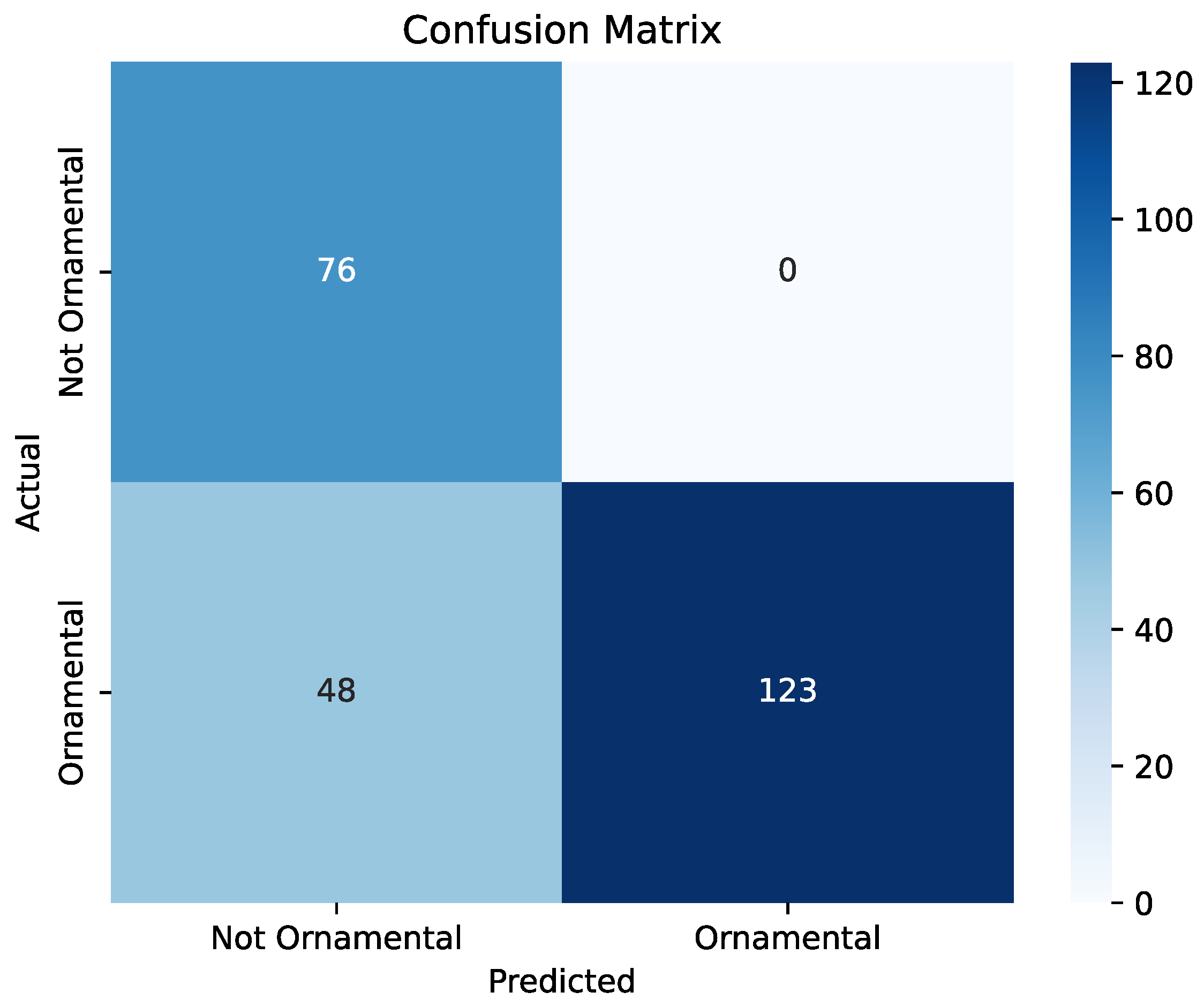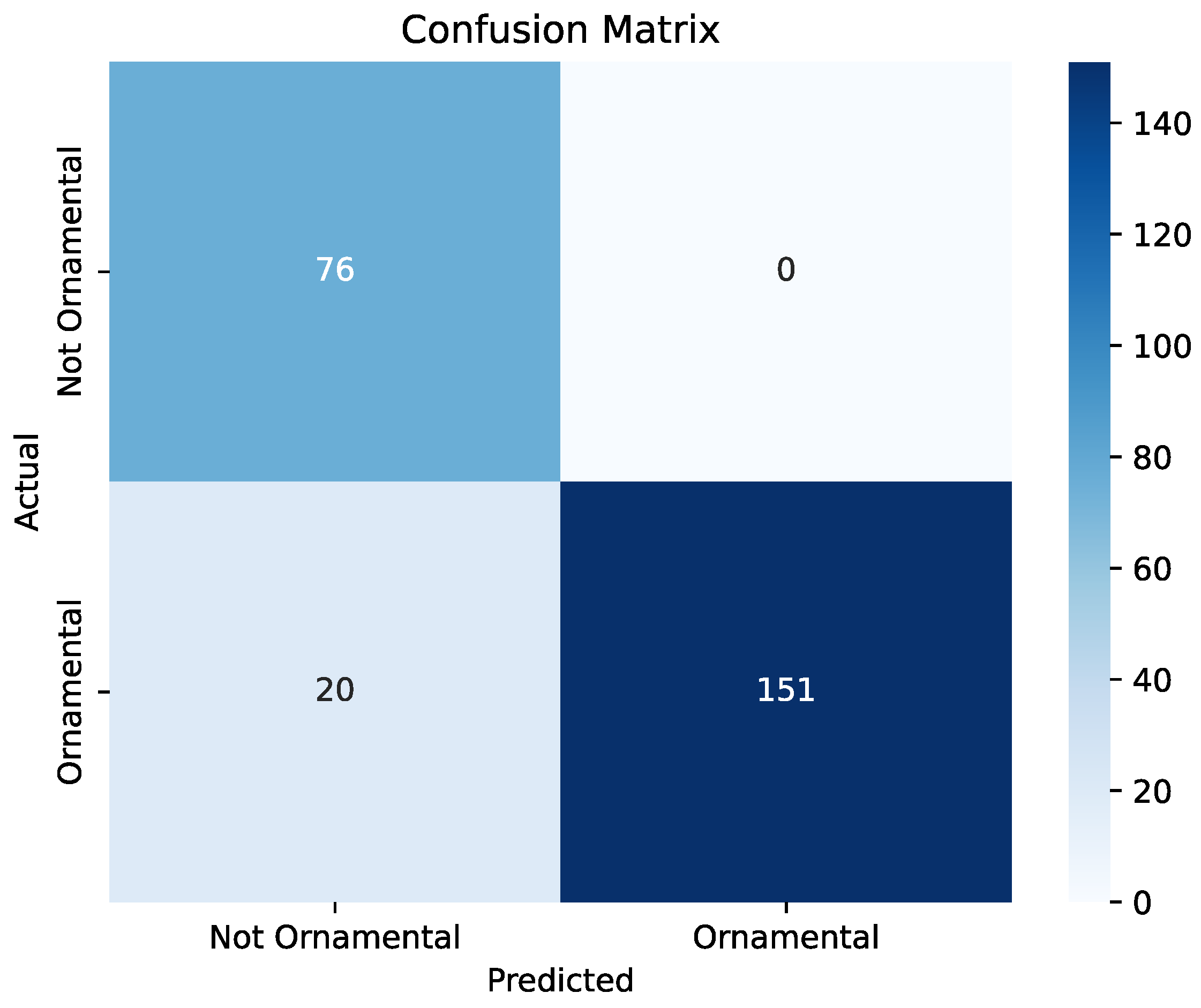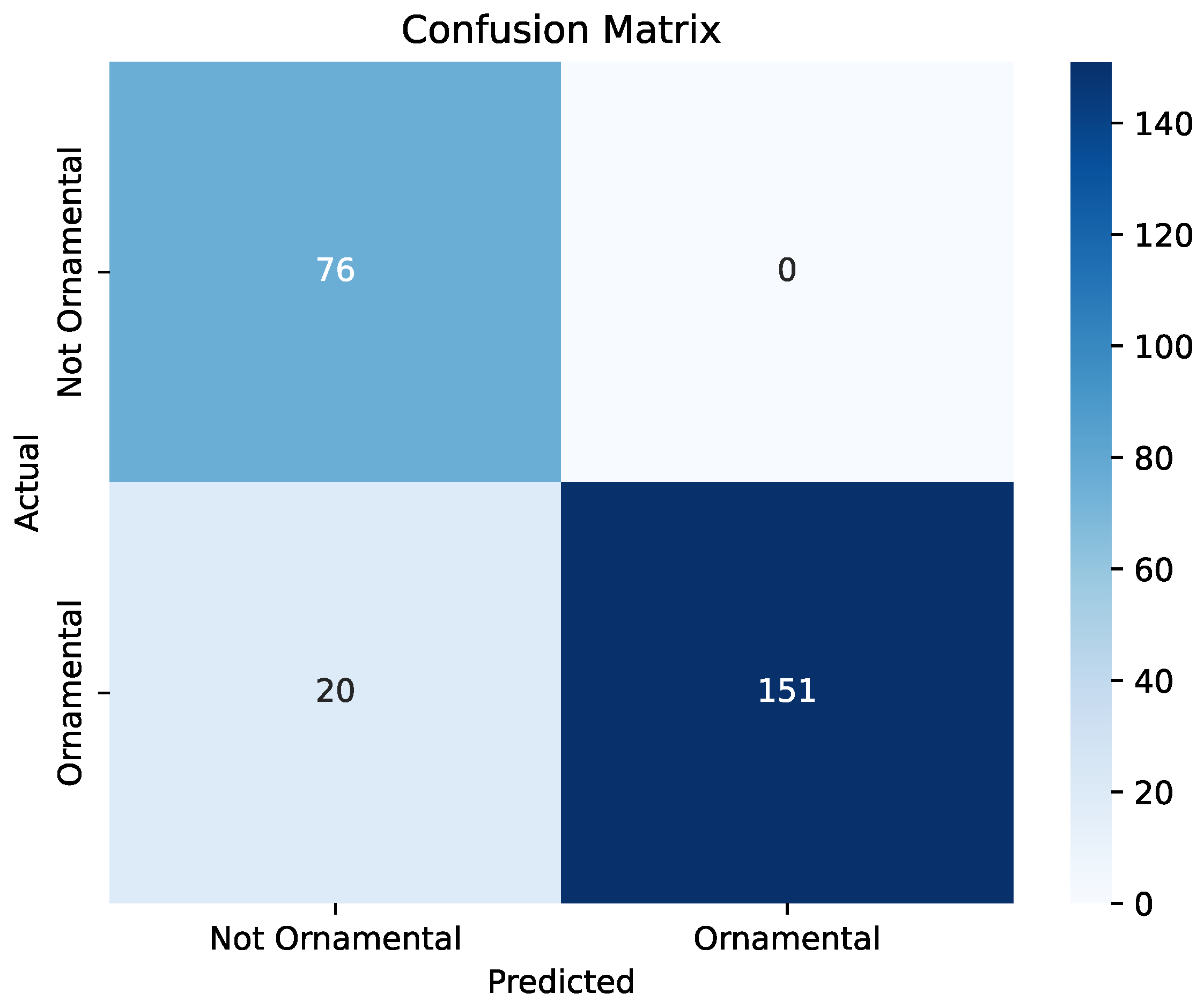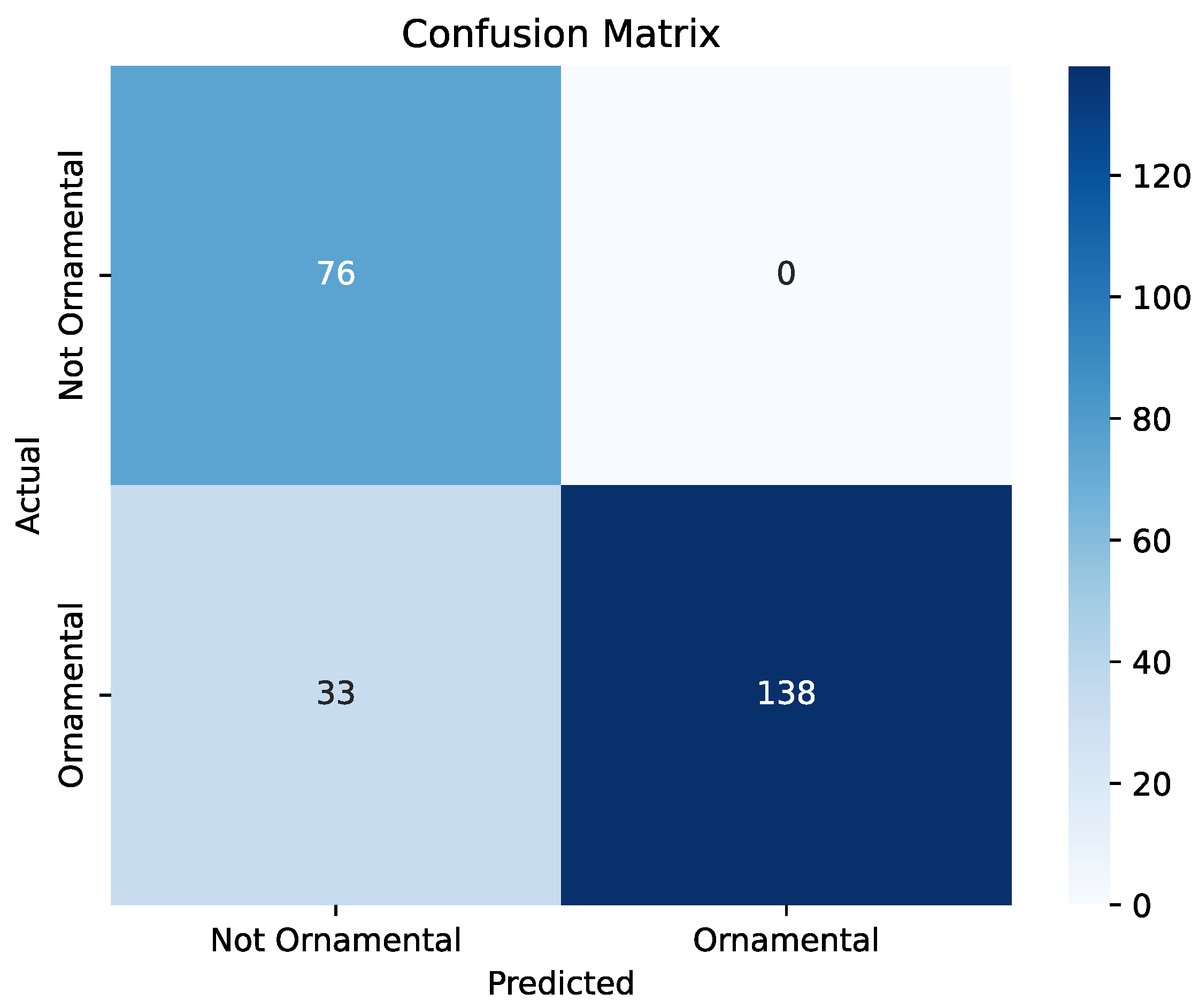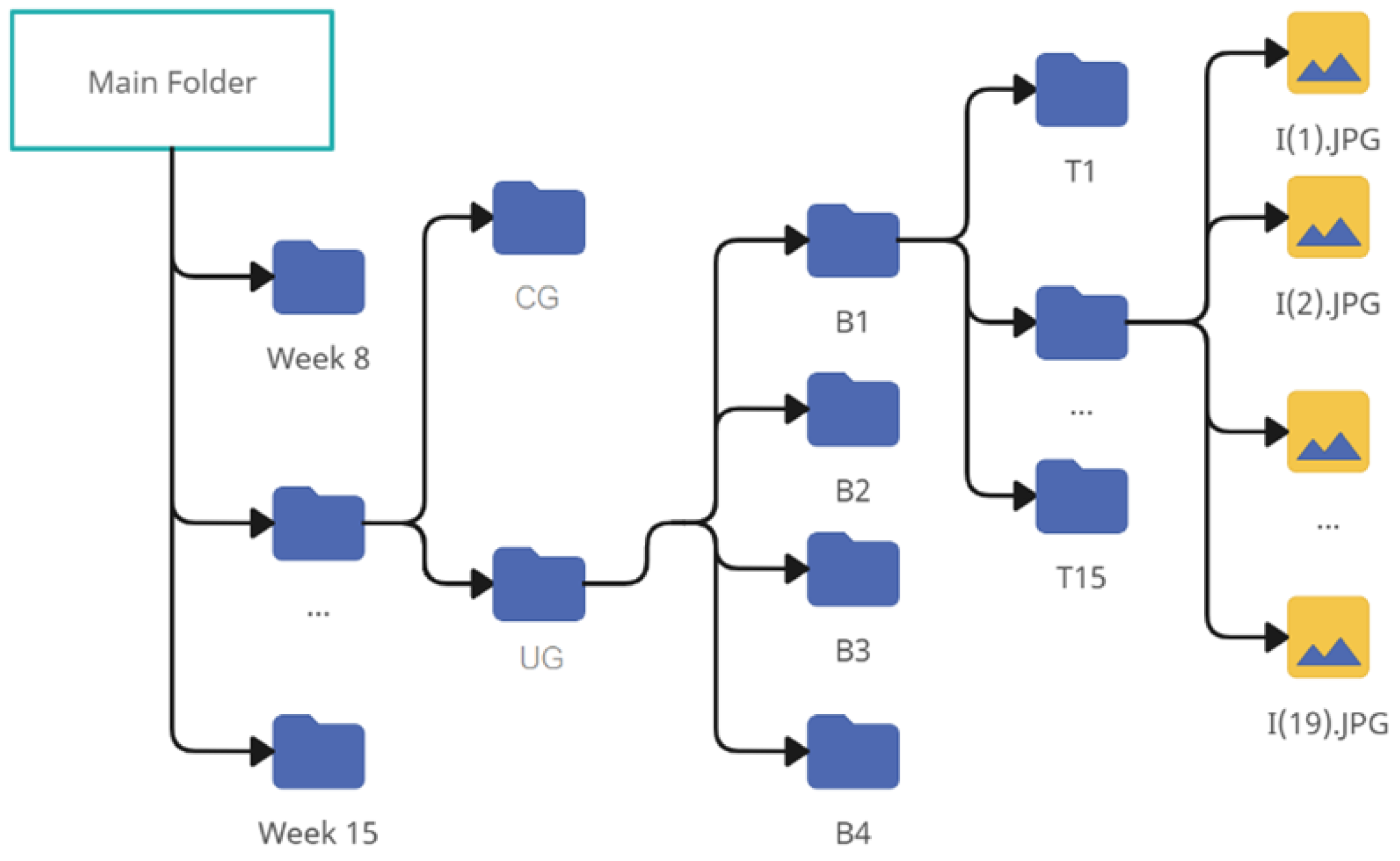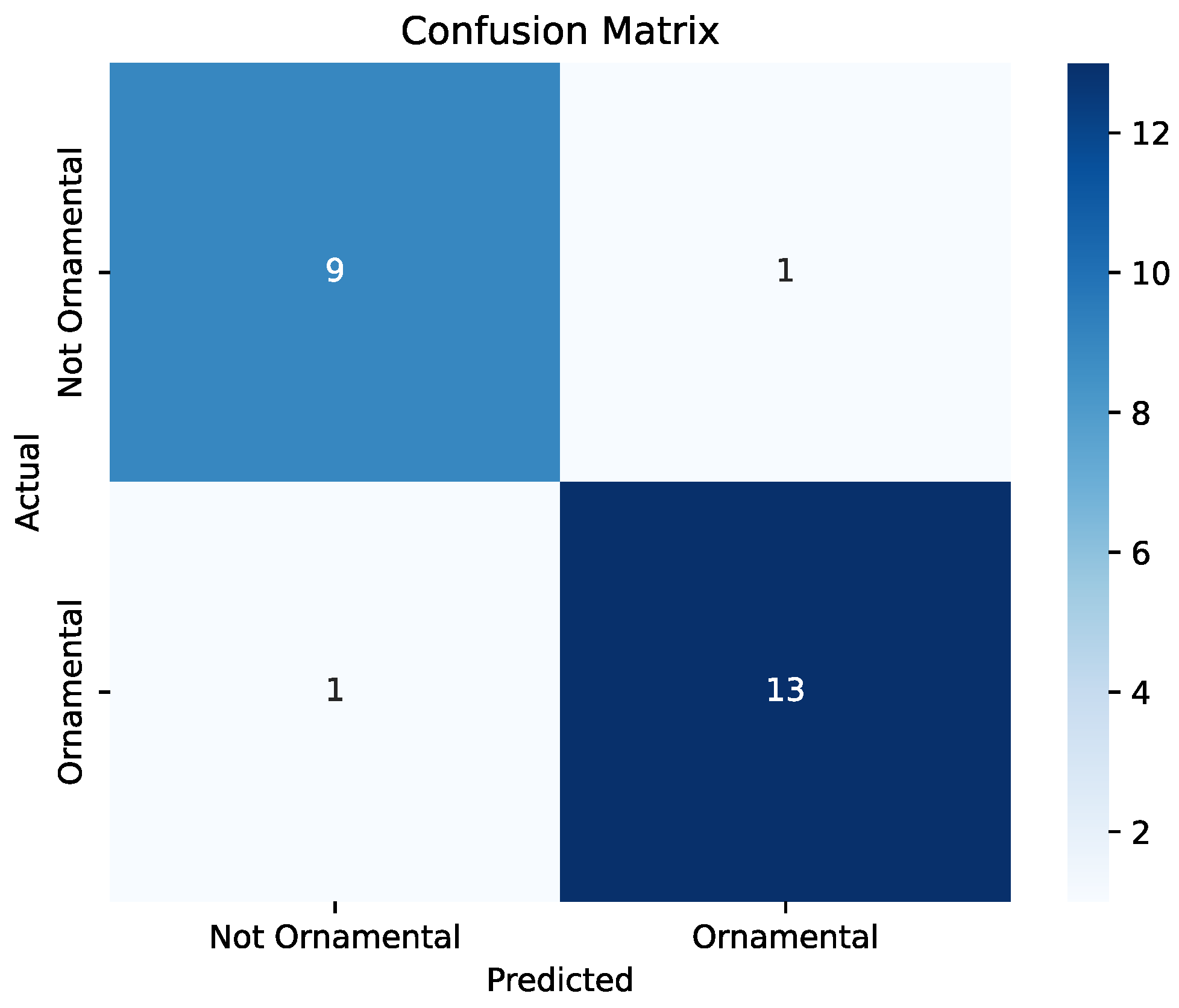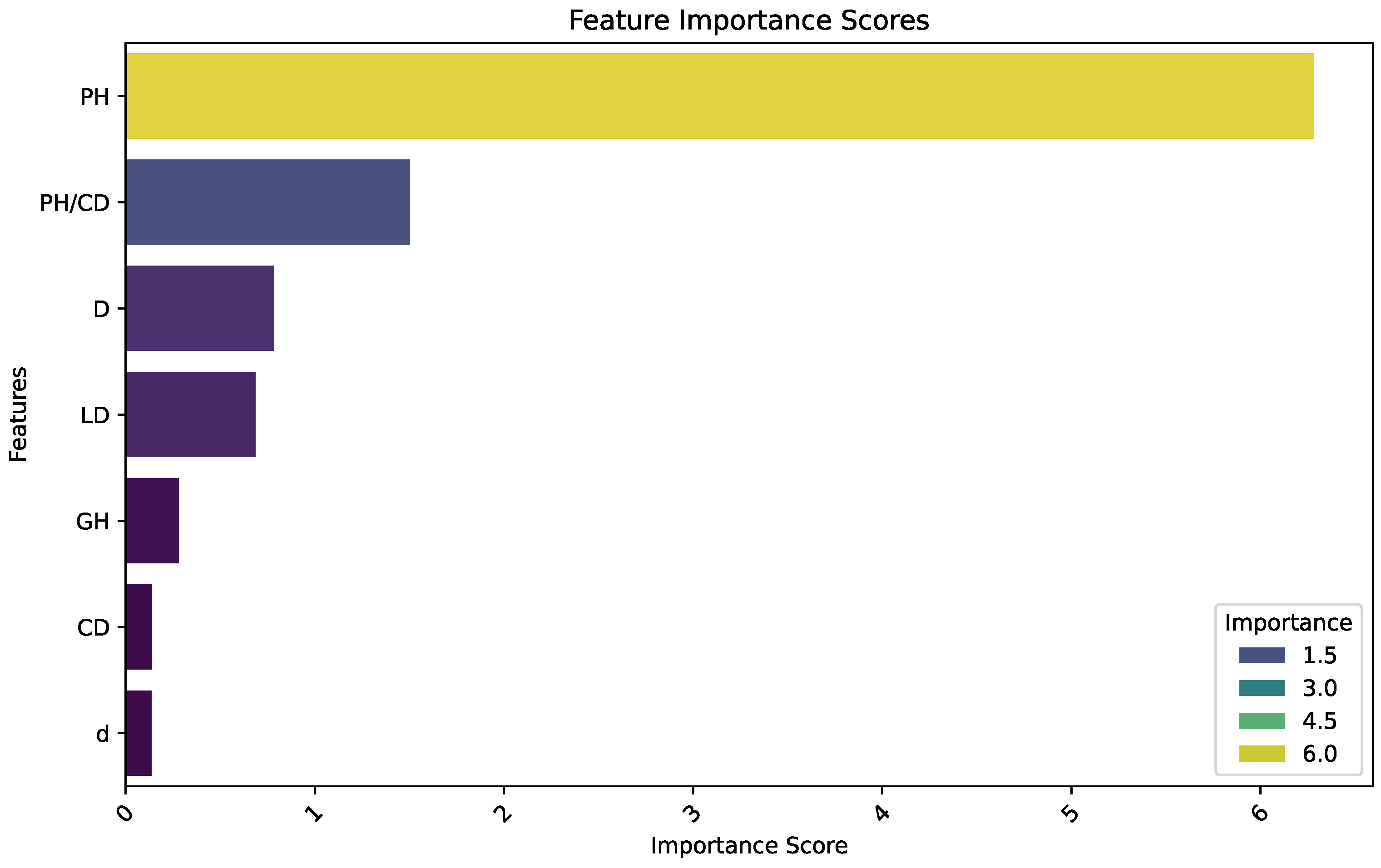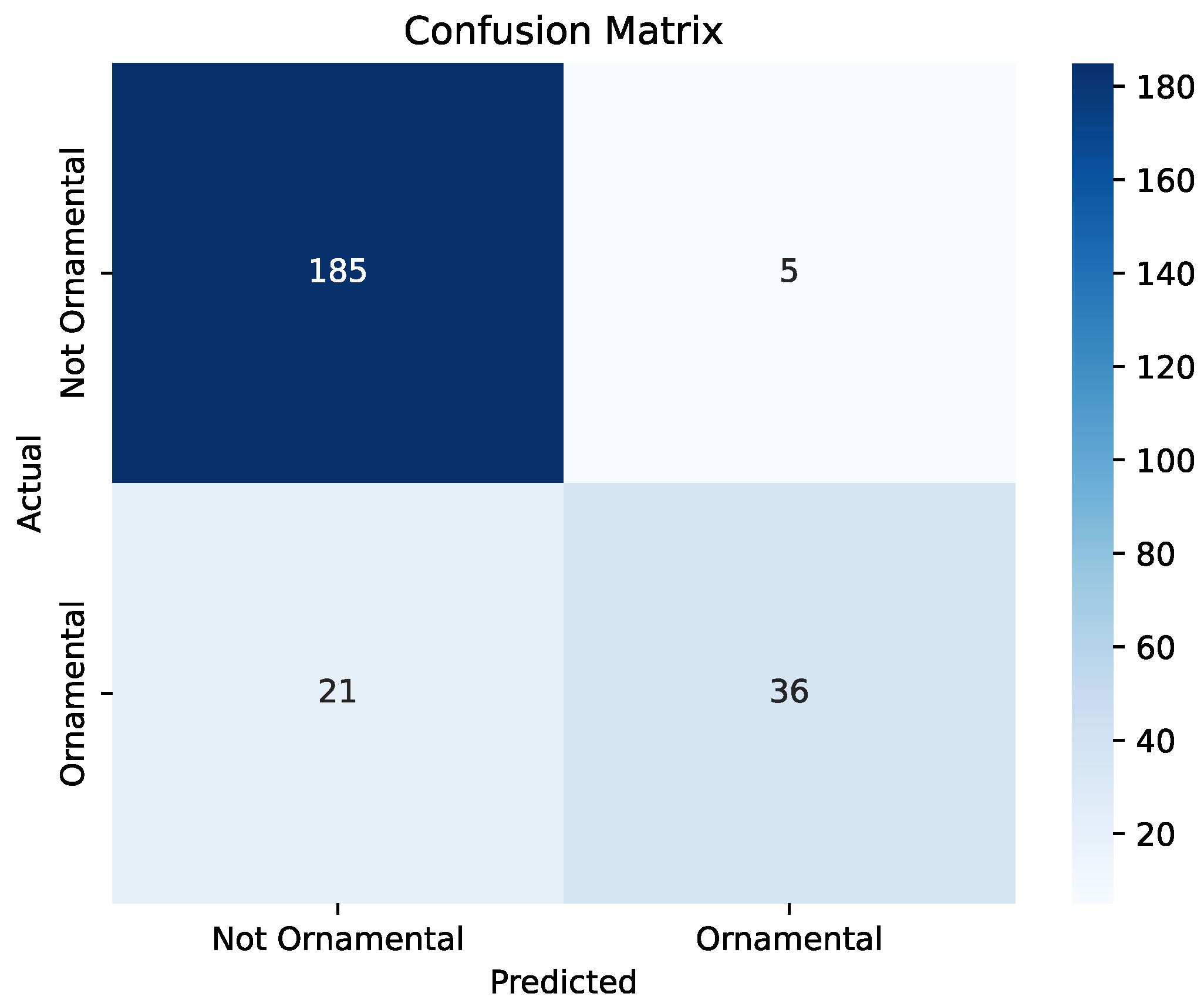1. Introduction
The ornamental horticulture industry has witnessed a significant increase in demand for unique and aesthetically pleasing plant varieties, particularly in urban [
1] and residential landscapes [
2]. Among these, pepper plants (
Capsicum spp.) have garnered attention not only for their culinary uses but also for their ornamental potential due to their vibrant fruits and diverse foliage characteristics [
3,
4,
5,
6]. As the market for ornamental plants continues to expand [
7,
8,
9], there is a pressing need for effective classification and prediction methods to identify and promote the most desirable varieties [
10,
11].
Anticipating the ornamental value of pepper plants is crucial for genetic breeding programs and genotype selection because it enables breeders to focus on traits that enhance the aesthetic appeal and marketability of plants [
12]. By evaluating characteristics such as plant habit, leaf density, fruit color, size, and arrangement at early developmental stages, breeders can identify promising genotypes with high ornamental potential. This early selection reduces time, effort, and resources spent on less desirable lines, streamlining the breeding process. Additionally, it allows breeders to cater to specific consumer preferences or landscaping needs, such as compact growth for container gardening or vibrant fruit colors for decorative purposes. Accurate anticipation of ornamental traits supports the development of unique and competitive cultivars, ensuring the success and sustainability of breeding programs in meeting market demands [
13].
Recent advancements in imaging technology and physiological measurement techniques have engendered novel opportunities for plant phenotyping, enabling researchers to assess ornamental traits more efficiently than traditional methods [
14,
15,
16]. Physiological and morphological measurements, such as chlorophyll content, leaf area, gas exchange rates, plant height, number of fruits, among others, provide critical insights into the health and vigor of plants, which are essential for ornamental quality assessment [
17,
18,
19]. On the other hand, RGB imaging has emerged as a powerful tool for non-destructive monitoring of plant traits, allowing for rapid assessment of morphology, color, and spatial distribution of features [
20,
21,
22]. The integration of these two approaches could enhance the accuracy of classification and prediction models for ornamental potential.
RGB images also allow for rapid assessment of morphology, color, and spatial distribution of organs such as flowers and fruits [
20,
21,
22]. In rapeseed (Brassica napus), models for counting the number of flowers, as well as estimating pod length and width, have been developed [
23]. RGB images combined with simple color index transformations have also been effective in quantifying color diversity in ornamental pepper fruits, providing useful results for breeding programs [
21].
Despite many studies in horticulture having used deep learning [
24], especially Convolutional Neural Networks (CNNs) such as ResNet, VGG, and EfficientNet, little work has been conducted regarding ornamental potential estimation from RGB images [
25].
This study aimed to compare the efficacy of morphological measurements and RGB images as data sources for classifying the ornamental potential of various pepper plant genotypes. In addition, the capability of undertaking predictions based on photos taken weeks before assessment is studied too. This comparison aims at identifying the feasibility of getting rid of costly measurements and replacing them by simply taking photos and further processing them. By employing machine learning algorithms, the capability of each data source to accurately distinguish between ornamental and non-ornamental varieties will be evaluated. This research not only highlights the ornamental potential of pepper plants but also contributes to the broader field of plant phenotyping, facilitating the selection of superior cultivars for ornamental purposes. As far as the authors are aware, this work is the first to forecast the ornamental potential of pepper plants (Capsicum spp.) multiple weeks ahead of time using image-based deep learning models.
The findings from this study may provide valuable insights for horticulturists, breeders, and landscape designers in promoting and utilizing pepper plants more effectively in ornamental applications.
4. Discussion
Four significant findings emerge from this investigation. Firstly, and mainly, the capability of estimating the ornamental potential of pepper plants from morphological measurements as well as from a single RGB image has been demonstrated feasible with similar accuracy in both cases. Importantly, this accurate prediction can be achieved both for plants growing under controlled and stress conditions. Second, when employing a single RGB image to predict ornamental potential, the accuracy is kept within acceptable values up to seven weeks in advance. Third, more accurate results are achieved when the image acquisition date is closer to the morphological assessment date, as this reduces uncertainty about the plant’s developmental stage. Fourth, increasing the RGB image resolution beyond 200 × 300 px does not improve the accuracy and thus seems sufficient for the model to keep enough level of detail about the plant under assessment. Nevertheless, this should be further validated in future work by testing more resolutions with a bigger dataset as well.
These demonstrated capabilities show particular promise for agronomic and horticultural use cases, specially in genetic breeding programs, as shown, for example, by a previous review article for ornamental potential prediction by Opara et al. [
38]. In particular, being able to accurately predict the ornamental potential of pepper plants is critical for early screening of seedlings and juvenile plants to avoid investing resources in specimens with anticipated poor ornamental characteristics [
39]. The models applied in this study demonstrated high accuracy in predicting the ornamental quality of pepper plants, even up to seven weeks in advance. This performance is due to the use of advanced feature transformations combined with deep neural network structures, capable of capturing and qualitatively describing subtle morphological variations between plants [
40].
As far as the authors are aware, this work is the first to forecast the ornamental potential of pepper plants (
Capsicum spp.) multiple weeks ahead of time using image-based deep learning models. In autogamous plants, such as pepper plants, seven to eight generations are typically required to obtain homozygous lines [
41]. Each selection cycle lasts on average 215 days [
42], that is, around 31 weeks. In each generation, hundreds or thousands of lines can be evaluated, depending on the crop. In pepper plants, 90 to 730 plants can be evaluated in a single F
2 population [
43,
44]. Anticipating each selection cycle in the breeding program by 7 weeks would allow accessions that are unfeasible to be discarded in the 24th week, which will save time and inputs used to maintain the plants. Thus, this innovative approach not only opens new avenues for integrating phenotyping and forecasting into breeding and production decision-making processes, but also creates opportunities to optimize the management of breeding populations, reduce resource waste, and accelerate the development of new cultivars. The predictive capacity of these models makes them particularly valuable for early-stage phenotypic selection, reducing reliance on late-stage evaluations and subjective visual assessments by experts.
In a broader context, in ornamental pepper plants, neural network models have been used to predict plant diameter and height but not before, up to our knowledge, to classify them as ornamental based on the estimated parameters [
26]. Chan et al. [
45], by combining multiple prediction models, were able to forecast a population of western flower thrips (
Frankliniella occidentalis), a notorious greenhouse pest, one week in advance in sweet pepper crops. Most studies applying prediction models in ornamental plants focus on species classification [
46,
47,
48,
49] and the classification of biotic and abiotic stresses [
50] as well, making it difficult to compare the results of this article with the literature.
Interestingly, a comparison of
Figure 5 and
Figure 7 reveals significant differences in feature relevance for classification, depending on the criterion used. This divergence highlights how the choice of criterion prioritizes distinct morphological or aesthetic traits, underscoring the subjectivity or contextual dependence of ornamental plant evaluation. In pepper plants, growth habit and leaf density depend on the genotype used [
51] and directly influence the photosynthetic rate, affecting plant vigor and size. In plants with erect architecture and dense foliage, self-shading can reduce light absorption, and this effect is also dependent on leaf orientation [
52]. Thus, even if still small, it is possible to detect variations in leaf density and growth habit that will directly influence ornamental quality in more advanced stages of development. The ornamental plant market, including cooperatives such as Veiling Holambra, adopts technical standards for uniformity of size, resistance, health, post-harvest life, and packaging to facilitate logistics, comply with phytosanitary legislation, and maintain consistent commercial value. According to Silveira [
53], standardization serves as a basis for evaluation. On the other hand, consumers of ornamental plants value aesthetic and symbolic aspects such as color, size, ease of maintenance, sustainability, and uniqueness. In pepper plants, aspects such as plant architecture, quantity, shape, color, and position of the fruits, as well as their durability in the vase, are valued [
54]. Plant breeders can use the gap between market standards and consumer taste as a strategic opportunity to guide the selection process for the development of cultivars within an ornamental genetic improvement program. This explains the divergence between the classification observed when using the Holambra criterion and the opinion of experts.
In this study, data from the two growth conditions (controlled and uncontrolled) were aggregated for analysis, as our primary objective was to assess overall patterns rather than condition-dependent effects. However, future work could reveal biologically meaningful insights by analyzing each condition separately, given that plants dynamically perceive and adapt their development in response to environmental cues such as light, temperature, and humidity [
55]. Furthermore, it is known that temperature is the main factor for plant growth and development, influencing characteristics such as root and shoot growth, seed yield, flowering and flower size, as well as sensitivity to pests [
56,
57,
58]. Environmental temperature influences the speed at which plants process energy. Thus, changes in relative humidity and temperature have a direct impact on the process of stomatal opening and photosynthesis, justifying the influence on plant growth and development [
59,
60]. In the literature, some authors have reported differences in the prediction of morphological characteristics of plants grown under stress conditions. Wen et al. [
61] investigated several factors that can influence the predictive modeling of plant growth, especially under stress conditions. The authors highlighted the use of temperature indices, environmental conditions during measurement, and the choice of appropriate statistical metrics to improve the accuracy and robustness of predictive models. In the study by Li et al. [
62], the correlation between environmental parameters and the growth of tea seedling biomass in different varieties was analyzed. To model this growth, the authors used a neural network architecture combining CNN and LSTM (CNN-LSTM). The environmental variables used in the predictive model included air temperature, soil temperature, and soil moisture, resulting in a significant improvement in the accuracy of predictions. In the study by Nabaei et al. [
63], a new framework integrating computer vision, machine learning, and environmental sensing was proposed for plant growth monitoring. The approach combined RGB images, plant phenotypic data, and environmental variables, such as temperature and humidity, with the aim of predicting water stress in controlled cultivation environments. The results indicated that the inclusion of environmental variables contributed significantly to increasing the predictive accuracy of the model. The inclusion of these variables in the ornamental classification models of pepper plants can be included in future lines of study.
The main drawback of this study is the relatively small dataset used, which may constrain the generalizability of the results, particularly for more complex or deeper model architectures. Future work should aim to expand the dataset across different growing conditions, developmental stages, and genotypic backgrounds.
Based on the results from this study, as well as the previous literature [
26], it can be expected that a two-stage approach using forecasting of morphological parameters and later estimation based on the predicted values from the first stage can be feasible and even improve the results of this study. It is strongly suggested that future work should follow this line of research.
A future line of research could study the capability of improving the predictions by including several photos instead of only one, gathering into the prediction model information about possible asymmetries of the plant. An important next step involves benchmarking these architectures with larger datasets and greater model capacity. The potential benefits of developing environment-specific ViT models (for controlled vs. uncontrolled greenhouses) or treatment-specific variants warrant further investigation. This may require a larger dataset to make this task feasible. Finally, this study reveals a significant divergence between the Veiling Holambra criterion and expert assessments. The weak alignment between this commercial standard and image-based or expert-informed evaluations suggests a need to critically reassess its role in breeding and selection programs. It would be insightful to focus on the development of more market-aligned criteria that better capture consumer preferences and ornamental value.
